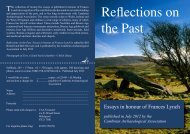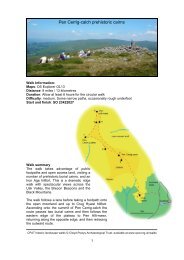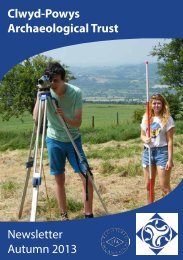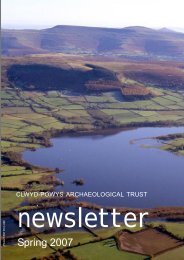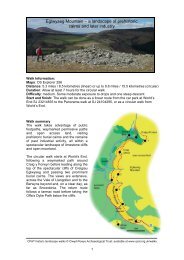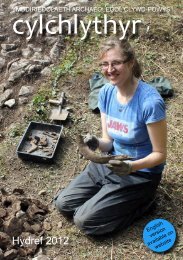Datganiad Cadwraeth Clawdd Offa Offa's Dyke Conservation ...
Datganiad Cadwraeth Clawdd Offa Offa's Dyke Conservation ...
Datganiad Cadwraeth Clawdd Offa Offa's Dyke Conservation ...
You also want an ePaper? Increase the reach of your titles
YUMPU automatically turns print PDFs into web optimized ePapers that Google loves.
30 <strong>Datganiad</strong> <strong>Cadwraeth</strong> <strong>Clawdd</strong> <strong>Offa</strong><strong>Offa</strong>'s <strong>Dyke</strong> <strong>Conservation</strong> Statement 30Mynediad ymwelwyr5.18 Mae mynediad ymwelwyr â Chlawdd <strong>Offa</strong> — yn bennafgysylltiedig â Llwybr <strong>Clawdd</strong> <strong>Offa</strong> sy’n dilyn 55 km ygwrthglawdd yn uniongyrchol — yn fater difrifol o safbwynterydu mewn rhai mannau. Cafodd darn Pulpud y Diafol ynSwydd Gaerloyw 32,000 o ymwelwyr ym 1995 (dataGwasanaeth Rheoli Llwybr <strong>Clawdd</strong> <strong>Offa</strong>) ac mae’r lefel hon obwysau gan gerddwyr yn anochel wedi arwain at ddifrod yn yrardal. Er bod y defnydd a wneir o weddill y gwrthglawdd yndipyn llai, mae creithiau llwybr ar yr henebyn yn gyffredin,gyda 52% o’r gwrthglawdd sy’n gysylltiedig â’r LlwybrCenedlaethol yn dioddef colledion pridd a llystyfiant (Cutts 1998).5.19 Mae’r broblem yn cael ei chanolbwyntio yn benodol llerhed y llwybr ar grib y clawdd, sef ardal mwyaf sensitif ygwrthglawdd o safbwynt archaeolegol, a’r un sy’n tueddu igael ei ffafrio gan gerddwyr gan fod golygfeydd da i’w cael, alle mae llwybr pendant i’w ddilyn. Mae traul ar lwybrau yncyfuno ag effeithiau eraill — megis gwartheg yn mathru,cysgod a phrosesau’r tywydd — ac yn cynhyrchunodweddion erydu mwy difrifol. Gall aflonyddu ar ygwrthglawdd sy’n gysylltiedig â gosod dodrefn llwybrau(camfeydd, grisiau ac ati) achosi difrod mwy sydyn.Visitor access5.18 Visitor access to <strong>Offa</strong>’s <strong>Dyke</strong>, primarily associated withthe <strong>Offa</strong>’s <strong>Dyke</strong> Path which directly follows 55 km of theearthwork, is a serious erosion issue at some locations. TheDevil’s Pulpit length of dyke in Gloucestershire had 32,000visitors in 1995 (<strong>Offa</strong>’s <strong>Dyke</strong> Path Management Service data)and this level of pedestrian pressure has inevitably resulted inconsiderable earthwork damage in the locality. Althoughusage of much of the rest of the monument is significantlyless, path scars on the monument are common, with 52% ofthe earthwork associated with the National Trail suffering soiland vegetation loss (Cutts 1998).5.19 The problem is particularly focused where the pathoccupies the crest of the dyke, which is both the mostarchaeologically sensitive area of the earthwork, and thatwhich tends to be most favoured by walkers as facilitatinggood views and a well defined route. Path wear typicallycombines with a cocktail of other effects — such as cattletrampling, shading and weathering processes — to producemore serious erosion features. Disturbance of the earthworkassociated with the installation of path furniture (stiles, stepsetc) can be a cause of more instant damage.Datblygiad5.20 Mae’n amlwg bod rhannau sylweddol o’r clawddwedi eu colli dros y blynyddoedd i ddatblygiad, gangynnwys adeiladu ffyrdd ac adeiladau a gweithgareddaueraill megis chwarela ac ailadeiladu tirweddau amaethyddolar raddfa fawr.5.21 Mae’r pwysau hyn y parhau heddiw, er yn cael eu rheolii ryw raddau dan brosesau Caniatâd Henebyn Rhestredig aPPG16 (Lloegr) a Chanllawiau Cynllunio (Cymru). Yn aml iawn,nid mater o dynnu darnau o’r clawdd yn gyfan-gwbl yw’rbroblem, ond tresmasu ar leoliad yr henebyn neu niwed arraddfa fechan i’r gwrthglawdd ei hunan sydd, er gwaethafhynny, yn cael effaith gronnol; rhybudd llesol i Glawdd <strong>Offa</strong>yw dad-restriad rhannau o Glawdd Wat ger Bwcle oherwyddtresmasiad graddol arno gan ddatblygiadau o’i gwmpas. Maepwysau datblygu eraill, megis ceisiadau aml ac anochel i osodgwasanaethau ar draws yr henebyn, hefyd yn cael effeithiauerydiad hirdymor.5.22 Yn gyffredinol, mae’n wir fod gan ddatblygiaduniongyrchol, o fewn amserlen fer iawn, y gallu i fod yr unbroses unigol mwyaf dinistriol yn uniongyrchol ar Glawdd <strong>Offa</strong>.Development5.20 It is evident that considerable sections of the dyke havebeen lost over the years to development episodes, includingconstruction of roads and buildings and other activities suchas quarrying and large scale reconstruction of agriculturallandscapes.5.21 Such pressures very much remain today, if controlled tosome extent within Scheduled Monument Consent and PPG16(England) and Planning Guidance (Wales) processes. Veryoften the issue is not so much one of complete removal of thedyke as it is encroachment on the setting of the monument orsmall scale damage to the earthwork itself which nonethelesshas a cumulative effect; a salutary warning for <strong>Offa</strong>’s <strong>Dyke</strong> isthe de-scheduling of sections of Wat’s <strong>Dyke</strong> near Bwcle dueto gradual impingement on it by surrounding development.Other development pressures, such as frequent and inevitablerequests to lay services across the monument, also have along term erosion consequence.5.22 It is generally the case that direct development has thecapacity to be, within short timescales, the single mostimmediately destructive process acting on <strong>Offa</strong>’s <strong>Dyke</strong>.



